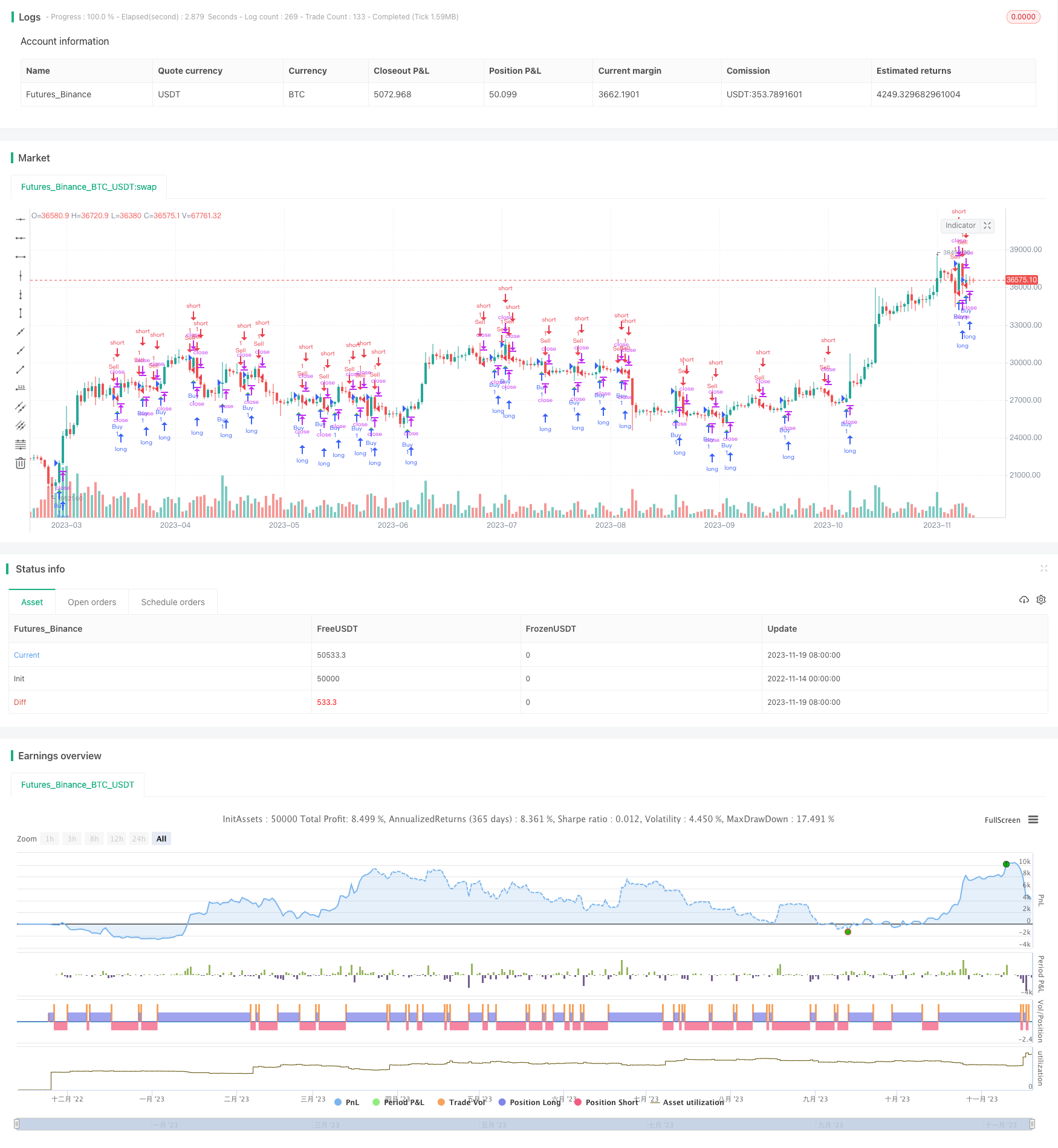
概述
逆向费希尔RSI平均真实范围多时间框架策略是一种试图通过计算逆向调整后的RSI指标在较高时间框架上的移动平均,来发现市场可能的反转点的量化交易策略。
策略原理
该策略首先计算一般的RSI指标,指标参数为RSI_pm代表计算RSI的周期长度。然后通过一个数学函数IF对原始RSI进行逆向调整,计算公式为IF(input)=>(exp(2*input)-1)/(exp(2*input)+1)。调整后的RSI指标传递给变量IF_RSI。
为了过滤掉过多的噪音,策略在IF_RSI的基础上再计算其在RSI_ps周期上的移动平均,得到最终的用来判断买卖点的指标wma_RSI。该指标再映射到0-100的区间。
最后,策略在一个更高的时间框架上画出该指标,并设置阈值线0.8和-0.8。当指标线从下向上突破0.8水平时产生买入信号;当指标线从上向下跌破-0.8水平时产生卖出信号。
策略优势
该策略通过双重平滑的方式处理RSI走势,能有效过滤掉过多噪音,锁定比较清晰的反转信号。双平滑分别应用在原始RSI指标和绝对值调整后的RSI指标。这种方法可以增强指标的平均回归特性,产生比较可靠的交易信号。
另外,该策略采用多时间框架分析方法,在一个更高级别的时间框架上识别指标的突破,能锁定长线上的反转机会,避免被过多的短期市场噪音干扰。
策略风险
该策略依赖均线指标判断买卖点,存在一定的滞后。长期牛市中,指标调整后上行空间可能会受到限制,无法充分捕捉趋势机会。
另一方面,指标的调整也可能错过短线调整后的反弹机会。如果不能适当优化指标参数,就可能面临一定的策略风险。
策略优化
可以尝试适当调整指标参数,使其更好地适应市场环境。例如可以测试不同的RSI计算周期,平滑周期参数,寻找最佳参数组合。
也可以考虑结合其他辅助指标来验证信号,提高策略稳定性。例如可以加入成交量指标、布林线等判断趋势信号强弱。
总结
该逆向费希尔RSI平均真实范围多时间框架策略,整体思路较为稳健,但仍需优化以适应更广泛的市场情况。值得进一步测试和改进,使其成为一个可靠的量化交易策略。
/*backtest
start: 2022-11-14 00:00:00
end: 2023-11-20 00:00:00
period: 1d
basePeriod: 1h
exchanges: [{"eid":"Futures_Binance","currency":"BTC_USDT"}]
*/
//@version=4
strategy(title = "Inverse Fisher RSI-MTF2", shorttitle="INRSIM2",overlay=true)
//Inputs
RSI_pm = input(5, title="RSI Main Period",minval=2)
RSI_ps = input(1, title="RSI Smooth Period",minval=0)
//Functions
IF(input)=>(exp(2*input)-1)/(exp(2*input)+1)
//RSI Calculation
raw_RSI=0.1*(rsi(close,RSI_pm)-50)
wma_RSI=wma(raw_RSI,RSI_ps)*100
IF_RSI = IF(wma_RSI)
resCustom = input(title="Timeframe", defval="1440" )
v=request.security(syminfo.tickerid, resCustom,IF_RSI)
a=v>0.8
b=v<-0.8
z=0.8
buy = crossover(v,z)
sell=crossunder(v,b)
plotshape(sell, title="sell", style=shape.triangledown,location=location.abovebar, color=red, transp=0, size=size.small)
plotshape(buy, title="buy", style=shape.triangleup,location=location.belowbar, color=green, transp=0, size=size.small)
//Strategy
golong = crossover(v,z)
goshort = crossunder(v,b)
strategy.entry("Buy",strategy.long,when = golong)
strategy.entry("Sell",strategy.short,when = goshort)